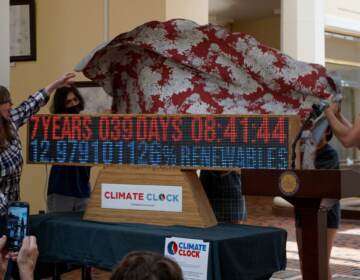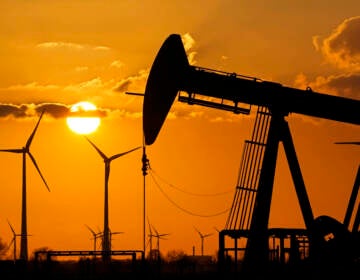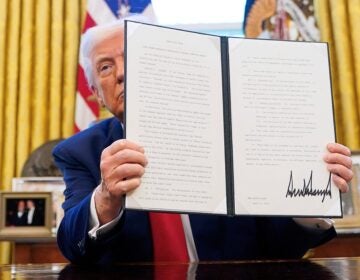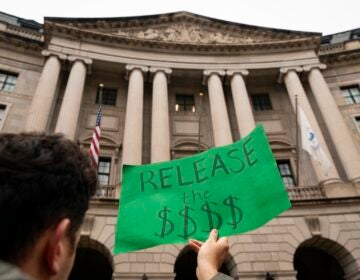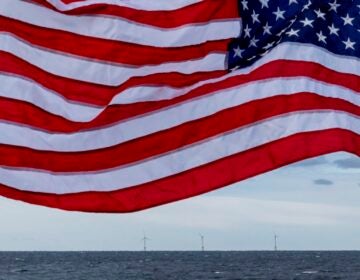Pa. climate rule takes effect as sides prepare for trial this fall
The commonwealth’s climate rule is in effect, but it will be months before Pennsylvanians know whether it’s here to stay.

The Bruce Mansfield Power Plant burns coal to generate electricity in Beaver County. (Amy Sisk / StateImpact Pennsylvania)
This story originally appeared on StateImpact Pennsylvania.
The commonwealth’s climate rule is in effect, but it will be months before Pennsylvanians know whether it’s here to stay.
Pennsylvania’s regulation allowing the state to join the Regional Greenhouse Gas Initiative took effect July 1, making it the first major fossil fuel-producing state to price carbon emissions.
But, two lawsuits against the rule are pending in Commonwealth Court and the judge overseeing both has yet to decide whether to pause the program until the full cases can be heard.
Arguments for one are tentatively set for September. The other might not be heard until November.
Without a preliminary injunction, Pennsylvania is free to begin participation in RGGI, a cap-and-trade program among 11 other states.
Under the regulation, power plants have to start keeping track of their emissions as of July 1, though they won’t have to pay for them yet.
The state Department of Environmental Protection is working to get the program running in the state. It has posted instructions and compliance forms on its website.
In the program, power plants must buy an allowance for each ton of carbon dioxide they emit, making dirtier sources more expensive and less competitive when selling electricity to the grid. In the most recent allowance auction, in June, the price was $13.90 per ton.
Pennsylvania’s program is designed to ramp up over the next few years. Plants have until March 1, 2024 to pay for all of their required 2022 allowances.
Republican legislative leaders, coal groups and power plant owners are asking Commonwealth Court to stop the rule.
Anthony Holtzman, an attorney with K&L Gates representing the coal and power plants groups, said plant owners will lose money on electricity sales–causing a chain reaction of losses for people who work in the plants and those who supply coal to the plants.
Senate GOP leaders are also arguing the regulation’s constitutionality. They say the fees paid under RGGI are a tax, which could only be levied by the legislative branch.
Matthew White, an attorney for DEP, argued there is no basis for a preliminary injunction, because he said there is no substantial harm that could happen between the rule taking effect and a future trial date. He said if the rule is delayed, the commonwealth would miss out on the first available auction for carbon allowances. That would mean lost revenue that could not be put toward air pollution controls.
He said the administration has the authority to join RGGI under the Air Pollution Control Act. He likened the allowance fees to a Turnpike toll, saying no one has a right to pollute just as no one has a right to drive on the Turnpike.
The state estimates the rule will prevent up to 227 million tons of carbon pollution by 2030. That’s equal to taking 44 million cars off the road for one year.
Joining RGGI is the main pillar of Gov. Tom Wolf’s climate plan. He is term-limited and will leave office in January, leaving the ultimate fate of RGGI in the hands of the next governor.
Democratic nominee Josh Shapiro has expressed doubts about RGGI, though after a U.S. Supreme Court decision limiting the authority of the federal Environmental Protection Agency, Shapiro tweeted that he would be “a Governor who protects our planet and invests in clean energy.”
Republican nominee Doug Mastriano has promised to remove the state from the effort on his first day, if elected.
RGGI states include Connecticut, Delaware, Maine, Maryland, Massachusetts, New Hampshire, New Jersey, New York, Rhode Island, Vermont, and Virginia.
States can use the money raised at RGGI auction to invest in clean energy, energy efficiency, and other measures to benefit people in the state.
RGGI administrators say CO2 emissions from power plants in participating states have fallen by 45 percent from a base level measured from 2006-2008. The cap has been adjusted to put more pressure on emitters. The latest change requires a 30 percent reduction from 2020 levels by the year 2030.
The most recent modeling from DEP expected RGGI to raise about $200 million in 2022, had the state joined at the beginning of the year.
Because Pennsylvania is joining RGGI through regulation, and not a law passed by the legislature, the money will go to the Clean Air Fund, where it can only be used to reduce air pollution.
The legislature could reallocate the money. The Wolf Administration and Democratic lawmakers have proposed a spending plan that would aid communities where coal plants close and areas that experience a higher pollution burden. The legislation has not gotten any traction so far.
Environmental groups, including PennFuture and Clean Air Council, applied to intervene in both Commonwealth Court cases but were denied.
Constellation, an energy company with a portfolio of nuclear plants and renewables projects, was also denied its attempt to join the cases.
WHYY is your source for fact-based, in-depth journalism and information. As a nonprofit organization, we rely on financial support from readers like you. Please give today.


